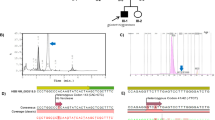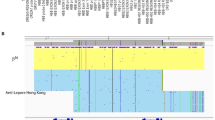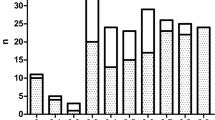Abstract
IT has been known for many years that thalassæmia exists among the Chinese. Hæmoglobin H was discovered in a Chinese family1 and has since been seen repeatedly in other Chinese families2 3. Thus in Singapore, over a period of fifteen months, 15 unrelated Chinese patients with anæmia were examples of hæmoglobin H disease. Another hæmoglobin, Q, has so far been observed only once in a Chinese family4. Of the other hæmoglobin variants, E has occasionally been noticed in Chinese. However, this is a rare finding, and the frequency cannot be compared with that observed in the neighbouring Burmese or Siamese, and certain Malayan, Cambodian and Indonesian communities. Hæmoglobins S, C and D, which are present at some frequency in certain non-Mongoloid populations, have so far never been described in Chinese, neither have been the rarer hæmoglobins I, K, L, M, N, O and P.
This is a preview of subscription content, access via your institution
Access options
Subscribe to this journal
Receive 51 print issues and online access
$199.00 per year
only $3.90 per issue
Buy this article
- Purchase on Springer Link
- Instant access to full article PDF
Prices may be subject to local taxes which are calculated during checkout
Similar content being viewed by others
References
Rigas, D. A., Koler, R. D., and Osgood, E. E., Science, 121, 372 (1955).
Lie-Injo Luan Eng, Poey Seng Hin, Kho Liau Keng, and Entenberg, P. M., Acta Hæmatol., 18, 156 (1957).
Vella, F., Proc. Alumni Assoc. Malaya, 10, 174 (1957).
Vella, F., Wells, R. H. C., Ager, J. A. M., and Lehmann, H., Brit. Med. J., i, 752 (1958).
Vella, F., Wells, R. H. C., and Leong, H. K., Man (in the press).
Edington, G. M., and Lehmann, H., Lancet, ii, 173 (1954).
Edington, G. M., Lehmann, H., and Schneider, R. G., Nature, 175, 850 (1955).
Schneider, R. G., and Haggard, M. B., Nature, 180, 1486 (1957).
Schwartz, H. C., Spaet, T. H., Zuelzer, W. W., Neel, J. V., Robinson, A. R., and Kaufman, S. F., Blood, 12, 238 (1957).
Ager, J. A. M., Lehmann, H., and Vandepitte, J. M., Lancet, i, 318 (1958).
Huisman, T. H. J., and Prins, H. K., J. Lab. Clin. Med., 46, 255 (1955).
Author information
Authors and Affiliations
Rights and permissions
About this article
Cite this article
VELLA, F., AGER, J. & LEHMANN, H. An Abnormal Hæmoglobin in a Chinese: Hæmoglobin G . Nature 182, 460–461 (1958). https://doi.org/10.1038/182460a0
Issue Date:
DOI: https://doi.org/10.1038/182460a0
This article is cited by
-
A New Hæmoglobin Variant (GGalveston)
Nature (1962)
-
A New Hæmoglobin Variant (the ‘Honolulu Type’) in a Chinese
Nature (1961)
Comments
By submitting a comment you agree to abide by our Terms and Community Guidelines. If you find something abusive or that does not comply with our terms or guidelines please flag it as inappropriate.



